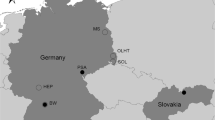Abstract
This study describes the craniometrical population pattern of the European golden jackal (Canis aureus moreoticus) populations inhabiting the southeastern part of its European range. The craniometric analysis was carried out using 18 linear skull and dental parameters. The analysis included 167 adult individuals (78 males and 89 females), originating from five populations inhabiting Bulgaria, Serbia and Hungary. The expected high degree of craniometric sexual dimorphism was confirmed. The multivariate differentiation analyses of linear characters were carried out separately for males and females from the five analyzed populations. The results are suggesting that Multiple Group Discriminant Analysis is able to “build” a model which classifies both males and females to the population from which they originated. The general pattern of craniometrical similarity in both males and females golden jackals in investigated area is not strongly bounded to the geographic origin of their population. Comparative population analysis of linear skull and dental parameters of golden jackals in southeastern Europe provided important information for future population differentiation studies across the whole golden jackal range.
Similar content being viewed by others
References
Arnold J., Humer A., Heltai M., Murariu D., Spassov N. & Hacklander K. 2012. Current status and distribution of Golden Jackals Canis aureus in Europe, Mammal Rev. 42 1): 1–11. DOI: https://doi.org/10.1111/j.1365-2907.2011.00185.x
Bošković I., Ozimec S., Šperanda M., Šprem N., Degmečić D., Ćurović M., Spalević V. & Florijančić T. 2015. Morphometric characteristics of the Golden Jackal populations in Eastern Croatia and Eastern Serbia. Agriculture & Forestry 61 3): 61–68 DOI: https://doi.org/10.17707/AgricultForest.61.3.06
Cirovic D., Milenkovic M., Paunovic M. & Penezic A. 2008. Aktuelno rasprostranjenje i faktori širenja šakala (Canis aureus L., 1758) u Srbiji [Present distribution and factors of range spread of Golden Jackal (Canis aureus L. 1758) in Serbia], pp. 93–102. In: Lovački savez Srbije [Hunting Association of Serbia] (ed.), Međunarodno savetovanje o krupnim zverima i tragačima po krvi, Žagubica [Proceedings of the International Conference on Large Carnivores], Žagubica.
Fabbri E., Caniglia R., Galov A., Arbanasić H., Lapini L., Boškovıć I., Florıjančıć T., Vlasseva A., Ahmed A., Mirchev R.L. & Randi E. 2014. Genetic structure and expansion of Golden Jackals (Canis aureus) in the north-western distribution range (Croatia and eastern Italian Alps). Conserv. Genet. 15: 187–199. DOI: https://doi.org/10.1007/s10592-013-0530-7
İbiş O., Aksöyek E., Özcan S. & Tez C. 2015. A preliminary phylogenetic analysis of Golden Jackals (Canis aureus) (Canidae: Carnivora: Mammalia) from Turkey based on mitochondrial D-loop sequences. Vertebr. Zool. 65 3): 391–396.
Jhala Y.V. & Moehlman P.D. 2004. Golden Jackal (Canis aureus), pp. 156–161. In: Sillero-Zubiri C., Hoffmann M. & Macdonald D.W. (eds), Canids: Foxes, Wolves, Jackals and Dogs, Status Survey and Conservation Action Plan, IUCN/SSC Canid Specialist Group, Gland, Switzerland and Cambridge, UK, 430 pp. ISBN: 2-8317-0786-2
Kryśtufek B. & Tvrtkovic N. 1990. Variability and identity of the jackals (Canis aureus) of Dalmatia. Ann. Nat. Hist. Mus. Wien Ser. B Bot. Zool. 91: 7–25.
Kryśtufek B., Murariu D. & Kurtonur C. 1997. Present distribution of the Golden Jackal Canis aureus in the Balkans and adjacent regions. Mammal Rev. 27 2): 109–114. DOI: https://doi.org/10.1111/j.1365-2907.1997.tb00375.x
Lombaard D. 1971 Age determination and growth curves in the black-backed jackal, Ann. Trans. Mus. 27 7): 135–169.
Loy A. 2007. Morphometrics and theriology: Homage to Marco Corti. Hystrix Ital. J. Mammal. (n.s.) 18 2): 115–136. DOI: https://doi.org/10.4404/hystrix-18.2-4398
Markov G. 2012. Jackal (Canis aureus L.) in Bulgaria: What is going on? Acta Zool. Bulg. Suppl. bd4: 67–71.
Markov G., Kocheva M. & Gospodinova M. 2017. Patterns of sexual dimorphism and phenetic variety among the populations of the Golden Jackal (Canis aureus) in Bulgaria: insights from craniometric data. Balkan J. Wildl. Res. 4 (1): 29–42. DOI: https://doi.org/10.15679/bjwr.v4i1.49
Porobic J., Ćirovic D. & Jojic V. 2016. Cranial variability of the Serbian Golden Jackal: Geographic variation, sexual dimorphism and allometry. Zool. Anz.–J. Comp. Zool. 261: 38–47. DOI: https://doi.org/10.1016/j.jcz.2016.03.004
Rezić A., Bošković I., Lubinu P., Piria P., Florijančić T. & Šprem N. 2017. Dimophism in the skull of the golden jackals (Canis aurereus Linnaeus1758) in the Western Balkans: A geometric morphometric approach. Pakistan J. Zool. 49: 8–12. DOI: https://doi.org/10.17582/journal.pjz/2017.49.3.989.997
Rutkowski R., Krofel M., Giannatos G., Ćirović D., Männil P., Volokh A.M., Lanszki J., Heltai M., Szabó S., Banea O.C., Yavruyan E., Hayrapetyan V., Kopaliani N., Miliou A., Tryfonopoulos G.A., Lymberakis P., Penezić A., Pakeltyt˙e G., Sucheckal E. & Bogdanowicz W. 2015. A European concern? Genetic structure and expansion of golden jackals (Canis aureus) in Europe and the Caucasus. PLoS One 10 (11): e0141236. DOI: https://doi.org/10.1371/journal.pone.0141236
StatSoft Inc. (2008) STATISTICA (Data analysis software system). Version 8.0. https://doi.org/www.statsoft.com.
Stoyanov S. 2012. Craniometric differentiation of Golden Jackals (Canis aureus L. 1758) in Bulgaria, pp. 48–56. In: Đorđević N. (ed.), Proceedings. International Symposium on Hunting “Modern Aspects of Sustainable Management of Game Population”, Zemun-Belgrade, Serbia, 189 pp.
Suchentrunk F., Markov G., George J.P., Smith S., Heltai M., Szabo L. & Zachos F. 2013. Population genetics of Golden Jackals (Canis aureus) from Bulgaria, Serbia, and Hungary. Mammal. Biol. Vol. 78 (Suppl.): 22–23. DOI: https://doi.org/10.1016/j.mambio.2013.07.002
Szabo L., Heltai M., Szucs E., Lanszki J. & Lehoczki R. 2009. Expansion range of the Golden Jackal in Hungary between 1997 and 2006. Mammalia 73 4): 307–311. DOI: https://doi.org/10.1515/MAMM.2009.048
Trouwborst A., Krofel M. & Linnell J.D.C. 2015. Legal implications of range expansions in a terrestrial carnivore: the case of the Golden Jackal (Canis aureus) in Europe, Biodivers. Conserv. 24 (10): 2593–2610. DOI: https://doi.org/10.1007/s10531-015-0948-y
Zachos F.E., Cirovic D., Kirschning L., Otto M., Hard G.B., Petersen B. & Honnen B. 2009. Genetic variability differentiation and founder effect in Golden Jackals (Canis aureus) from Serbia as revealed by mitochondrial DNA and nuclear microsatellite loci. Biochem. Genet. 47: 241–250. DOI: https://doi.org/10.1007/s10528-009-9221-y
Author information
Authors and Affiliations
Corresponding author
Rights and permissions
About this article
Cite this article
Markov, G., Heltai, M., Nikolov, I. et al. Phenetic similarity of European golden jackal (Canis aureus moreoticus) populations from southeastern Europe based on craniometric data. Biologia 72, 1355–1361 (2017). https://doi.org/10.1515/biolog-2017-0148
Received:
Accepted:
Published:
Issue Date:
DOI: https://doi.org/10.1515/biolog-2017-0148



